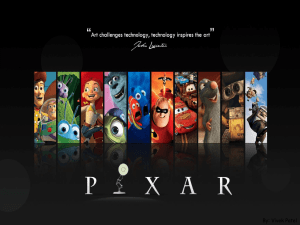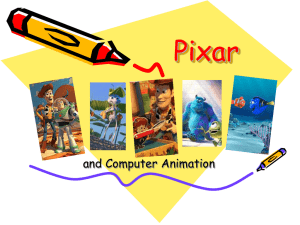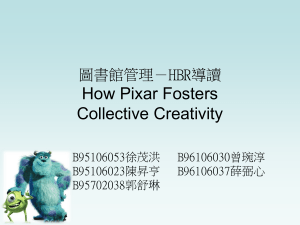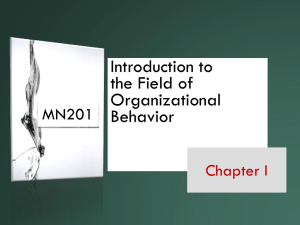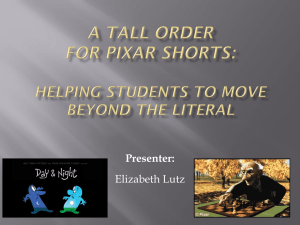'A People-‐Centred Business' -‐ A Case Study on Pixar Animation
advertisement
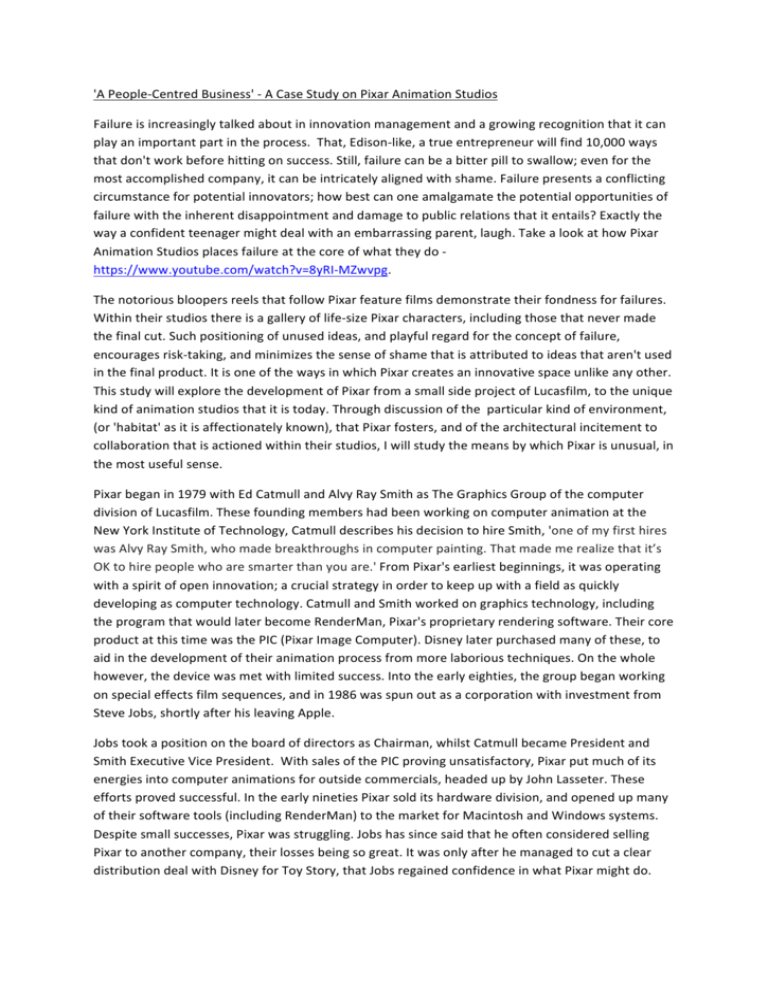
'A People-­‐Centred Business' -­‐ A Case Study on Pixar Animation Studios Failure is increasingly talked about in innovation management and a growing recognition that it can play an important part in the process. That, Edison-­‐like, a true entrepreneur will find 10,000 ways that don't work before hitting on success. Still, failure can be a bitter pill to swallow; even for the most accomplished company, it can be intricately aligned with shame. Failure presents a conflicting circumstance for potential innovators; how best can one amalgamate the potential opportunities of failure with the inherent disappointment and damage to public relations that it entails? Exactly the way a confident teenager might deal with an embarrassing parent, laugh. Take a look at how Pixar Animation Studios places failure at the core of what they do -­‐ https://www.youtube.com/watch?v=8yRI-­‐MZwvpg. The notorious bloopers reels that follow Pixar feature films demonstrate their fondness for failures. Within their studios there is a gallery of life-­‐size Pixar characters, including those that never made the final cut. Such positioning of unused ideas, and playful regard for the concept of failure, encourages risk-­‐taking, and minimizes the sense of shame that is attributed to ideas that aren't used in the final product. It is one of the ways in which Pixar creates an innovative space unlike any other. This study will explore the development of Pixar from a small side project of Lucasfilm, to the unique kind of animation studios that it is today. Through discussion of the particular kind of environment, (or 'habitat' as it is affectionately known), that Pixar fosters, and of the architectural incitement to collaboration that is actioned within their studios, I will study the means by which Pixar is unusual, in the most useful sense. Pixar began in 1979 with Ed Catmull and Alvy Ray Smith as The Graphics Group of the computer division of Lucasfilm. These founding members had been working on computer animation at the New York Institute of Technology, Catmull describes his decision to hire Smith, 'one of my first hires was Alvy Ray Smith, who made breakthroughs in computer painting. That made me realize that it’s OK to hire people who are smarter than you are.' From Pixar's earliest beginnings, it was operating with a spirit of open innovation; a crucial strategy in order to keep up with a field as quickly developing as computer technology. Catmull and Smith worked on graphics technology, including the program that would later become RenderMan, Pixar's proprietary rendering software. Their core product at this time was the PIC (Pixar Image Computer). Disney later purchased many of these, to aid in the development of their animation process from more laborious techniques. On the whole however, the device was met with limited success. Into the early eighties, the group began working on special effects film sequences, and in 1986 was spun out as a corporation with investment from Steve Jobs, shortly after his leaving Apple. Jobs took a position on the board of directors as Chairman, whilst Catmull became President and Smith Executive Vice President. With sales of the PIC proving unsatisfactory, Pixar put much of its energies into computer animations for outside commercials, headed up by John Lasseter. These efforts proved successful. In the early nineties Pixar sold its hardware division, and opened up many of their software tools (including RenderMan) to the market for Macintosh and Windows systems. Despite small successes, Pixar was struggling. Jobs has since said that he often considered selling Pixar to another company, their losses being so great. It was only after he managed to cut a clear distribution deal with Disney for Toy Story, that Jobs regained confidence in what Pixar might do. It was 1995's Toy Story that gave Pixar the direction it had needed. Directed by Lasseter, Toy Story went on to make $361 million worldwide. This success allowed Pixar to expand into its Emeryville Campus. A photo tour of the campus in 2008 can be viewed here -­‐ http://www.rottentomatoes.com/m/wall_e/news/1741321/1/exclusive_inside_pixar_-­‐ _a_photo_tour/ and here -­‐ http://www.buzzfeed.com/adambvary/inside-­‐steve-­‐jobs-­‐mindblowing-­‐pixar-­‐ campus#.fu7Aq9bxb As pleasant as it an exercise in interior design, the Emeryville campus is integral to the Pixar ethos. As Craig Payne, the senior design project manager, describes: Originally we were going to build four buildings, around a piazza. Steve (Jobs) thought about that — and he decided that he wanted everybody under one roof, and also he didn’t want it more than two stories, so it became a very big building. Steve’s always had the philosophy of bringing people together in one central space. The vast building's centre is The Atrium, where the only bathrooms in the entire building are located. Staff from various departments are forced to interact with each other. The Atrium is also where all the catering amenities (including a free cereal bar) are located. A video displaying this space, and further expounding on the 'forced collisions' and 'spontaneous collaborations' that it fosters, can be viewed here -­‐ https://www.youtube.com/watch?v=CXtsEhUwTmc. The Emeryville campus, though secretive, has become somewhat of a gimmick. But there are valid and important consequences to many of the wacky features. Staff are encouraged to buy in to the company and foster their individuality by decorating their own work cabin, (designs include a Tiki cabin and scaled-­‐up Duplex houses). Complete wellbeing is nurtured with a swimming pool, football pitch and volleyball courts on campus. These facilities are complemented by a variety of classes such as Pilates and Yoga. Doctors, masseuses and full-­‐time ergonomic experts visit the campus regularly. Such facilities must compensate at least a little for the rumoured intense work periods prior to a film's release. Pixar University, a program of events, lectures and workshops available to Pixar employees, was founded in 1997. Each employee can spend up to 4 hours a week taking part in the program, which includes activities such as storytelling, painting, belly-­‐dancing, improvisation, sculpting and juggling, to name a few. The intention is that this creative space will allow employees to network and work together creatively, aside from their primary projects. By providing a program of activities that are both relevant and occasionally, silly, PU allows employees to become better workers by both developing their artistic skills, whilst, through activities such as improvisation, learning to fail in a safe and productive way. In many ways the ethos that is encouraged by the Emeryville 'Campus' is a very old-­‐fashioned one; a Platonic Academy in which discourse and confrontation are vital. Catmull describes his eagerness to create a space in which workers are encouraged to act as individuals, able and willing to take risks: Management’s job is not to prevent risk but to build the capability to recover when failures occur. It must be safe to tell the truth. To act in this fashion, we as executives have to resist our natural tendency to avoid or minimize risks, which, of course, is much easier said than done. In the movie business and plenty of others, this instinct leads executives to choose to copy successes rather than try to create something brand-­‐new. All stages in the production process are valued within Pixar. The creative and technology teams are simply not allowed to perfect ideas before sharing them. Collaboration is key, and allows Pixar to make quicker decisions, experimenting with ideas before moving on to the next. Employees must be comfortable with the prospect of their idea being either dismissed or developed. Equally, after every film, teams get together to do a 'brain dump', discussing which areas could be improved and which ones worked well. This kind of self-­‐analysis and open criticism prompts Pixar to continue developing their systems. Catmull cites as his inspiration W. Edward Deming, the American engineer who expounded the necessity of quality control on the assembly line floor. Giving each worker the ability to shut down the line in case of fault, Deming gave all staff ownership over the final product. This placement of people at the heart of how Pixar operates puts into practice that infamous slogan of Jobs', 'think different'. A huge proportion of Pixar's resources are put into the wellbeing and development of its staff. In many senses, it is a risk. Like university students accustomising themselves to new freedoms, Pixar's liberal work environment could prompt its staff to laziness. This is a reasonable fear, and one that no doubt has deterred other companies from taking similar steps. In the case of Pixar however, their unusual systems and 'habitat' has had the opposite effect. By placing trust in their employees, Pixar fosters their creativity and ability to innovate. In the words of Randy Nelson, Dean of Pixar University: We've made the leap from an idea-­‐centred business to a people-­‐centred business. Instead of developing ideas, we develop people. Instead of investing in ideas, we invest in people. We're trying to create a culture of learning, filled with lifelong learners. It's no trick for talented people to be interesting, but it's a gift to be interested. We want an organization filled with interested people. To continue the university metaphor, students that are energised by their subject of study rarely play truant. Pixar began as a couple of innovators working with an emerging technology. In its 36 year history it has had to manage innovation through dramatic changes in financial circumstances and technological breakthroughs. In 2009 George Buckley, CEO of 3M, ranked Pixar number one in a list of most innovative companies because he believes 'Pixar is changing the way movies are made.' Pixar's management structure is integral to its success. By engaging and developing its employees, Pixar fosters innovators, thus safeguarding its own ability to change for the better. Further resources can be found at Pixar's Website -­‐ http://www.pixar.com/ Disney/Pixar's YouTube Channel -­‐ https://www.youtube.com/user/DisneyPixar
